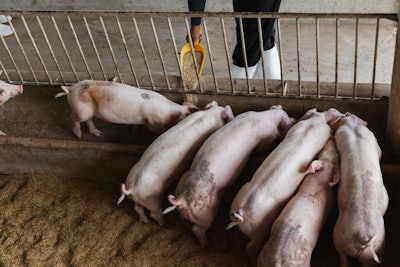
Benefits of copper aren’t limited to bacteria and gut health in swine, new study says
The role of copper in digestion and metabolism may go beyond its traditional use for improving gut health in swine, according to a new study from the University of Illinois.
Producers have long used copper to improve the feed-to-growth ratio in growing pigs, but the exact reason why the mineral has this effect has remained unclear, according to Hans Stein, a professor of animal science at the University of Illinois. Copper exhibits anti-microbial properties, which has led many to believe the nutrient regulates bacteria in the gut, improving feed utilization by reducing bacterial infections and diarrhea.
However, new work by Stein’s research group in Illinois suggests the benefits of copper may go beyond the known antibacterial properties. In the study, published in the journal Animal Feed Science and Technology, some pigs received diets supplemented with copper hydroxychloride, while others were fed a base diet containing corn, soybean meal, corn bran, cornstrach and casein but no additional copper. While the pigs enjoyed a greater rate of weight gain on the same amount of feed when fed the supplement, the researchers could find no evidence that the animals’ uptake of energy from their feed actually increased.
Instead, Stein said, copper appears to improve feed utilization by changing the expression of genes related to the utilization of fats after they are absorbed in the digestive tract. Previous work by his research group showed that by increasing the activity of key genes, copper appears to influence weight gain and the composition of fats in the animal itself, reducing the concentration of polyunsaturated fatty acids, and increasing the amount of iodine and unsaturated fats in the pigs’ back fat.
The researchers had come across evidence that copper influences gene expression in other study reports, Stein said, but until their recent work they hadn’t expected this relationship to be the potential explanation for copper’s ability to improve feed performance.
“It was not something that we originally thought of as the main reason for the improved feed conversion rate,” Stein said. “It was something that, after we had tried some other things and ruled some other things out, that’s when we came across this gene expression stuff. But that was not our first thought.”
The results of their work won’t necessarily change the way copper is used in production settings, Stein said — copper still reliably improves feed utilization as well as modulating gut bacteria and decreasing diarrhea. However, he noted that more of a good thing does not always yield even better results. The pigs in his studies received 150 mg of copper per kilogram of feed. Supplementing at higher levels, he said, will not result in additive health effects, and it can become toxic to the pigs if copper is fed above 200 mg per kilogram of feed.
He also noted that different forms of copper may not have the same effect as in this study of copper hydroxychloride.














